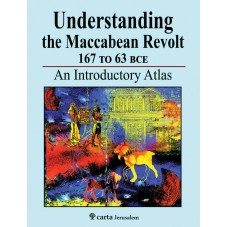16 other products in the same category:
-

Understandin...
$19.95
View
-

Teaching...
$35.00
View
-

Bible...
$14.95
View
-

Carta’s...
$9.95
View
-

Jerusalem in...
$15.95
View
-

From Sinai...
$14.95
View
-

Carta’s New...
$60.00
View
-

The Sacred...
$120.00
View
-

War and...
$17.95
View
-

ANCESTRAL...
$14.75
View
-

THE EXODUS...
$14.75
View
-

HASMONEAN...
$14.75
View
-

The Raging...
$58.80
View
-

The World’s...
$84.00
View
-

Understandin...
$19.95
View
-

The Raging...
$88.00
View
By: Michael Avi-Yonah; Shmuel Safrai; Ze’ev Safrai
Antiochus IV Epiphanes’ harsh decrees had the effect of accelerating Jewish resistance to Greek customs rather than the intended opposite. In his belief that the Jewish nation was ready for Hellenization, he forbade religious practice and dedicated the Jewish temple to a Greek deity. This and other acts of religious persecution led to the uprising in 167 BCE. The Seleucids had counted on Mattathias, son of John and a leader of the community to accept the king’s rulings.
Mattathias, however, refused and, seeing one of his own people offer a pagan sacrifice, he killed the blasphemer. Thus began the Jewish struggle for freedom that lasted for over two decades and ushered in the Hasmonean kingdom.
40 pp.; 23×30 cm (9×12 in.); full color; maps, illustrations, and photographs; paper
ISBN: 978-965-220-875-0
About the Authors
Michael Avi-Yonah (1904–74) was Professor of Archaeology and History of Art at The Hebrew University of Jerusalem. He wrote numerous books and papers, among them In the Time of Rome and Byzantium, A Historical Geography of the Holy Land from the Return to Zion until the Arab Conquest, and Gazetteer of Roman Palestine. He planned and constructed a model of Second Temple Jerusalem at 1:50 scale, now on display at the Israel Museum, Jerusalem.
Shmuel Safrai (1919–2003), a founding member of the Jerusalem School of Synoptic Research, was emeritus professor of Jewish History of the Mishnaic and Talmudic Period at The Hebrew University of Jerusalem. Safrai was the recipient of several literary prizes for his research, and wrote over 80 articles and 12 books.
Ze’ev Safrai is professor emeritus in the Martin Susz Department of Land of Israel Studies at Bar Ilan University in Israel. He has written and edited more than ten books, among them The Economy of Roman Palestine: The Missing Century, as well as dozens of articles.
Shopping Cart
Categories
-
Bible Studies
- Battles
- Bible History
- Biblical Judges
- Biblical Prophets
- Digital
- Divided Kingdom
- Exodus and Conquest of Canaan
- Herodian period
- Historical Geography
- Introductory Maps
- Jerusalem
- Jesus
- Kingdom of Judah
- Kings
- New Testament
- Old Testament
- Patriarchs
- Bible Wall Maps & Charts
- The United Monarchy
- Tribes of Israel
- Religion
- Christianity
-
History
- Archaeology
- Bible History
- Jerusalem
- New Testament
- Old Testament
- Tribes of Israel
- History
- Assyrian Empire
- Babylonian Empire
- Bar Kokhba revolt
- Battles
- Bronze Age
- Canaanite Period
- Divided Kingdom
- Early Bronze Age
- Exodus and Conquest of Canaan
- Greek Empire
- Hasmoneans
- Hellenistic period
- Herodian period
- Introductory Maps
- Iron Age
- Israel and Judah
- Jewish Revolt against the Romans
- Kingdom of Judah
- Maccabees
- Persian Empire
- Roman Conquest
- The United Monarchy
- Islam
- Israel Guides
- Religion
- Wall Maps & Charts
- Middle Ages
- Israelite Period
- Judaism
- Historical Geography
- Understanding
- Archaeology
- Jerusalem
- Hebrew Script
- Guides & Maps
- eBooks
- New titles


